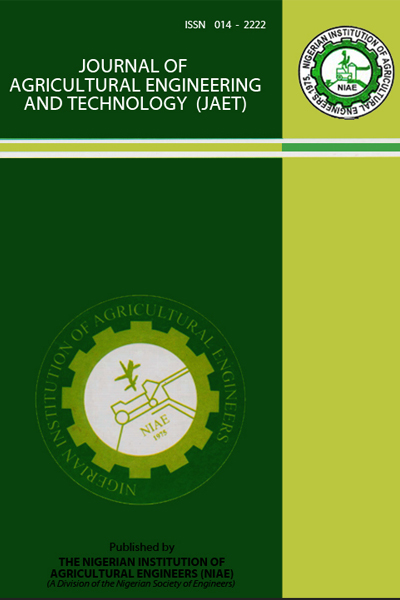SELECTED PHYSICAL AND AERODYNAMIC PROPERTIES OF NERICA
Keywords:
NERICA, aerodynamic, drag force, reynolds number, physical propertiesAbstract
moisture contents of 13%, 17%, and 20% (w.b). Four varieties of NERICA namely; FARO 44, FARO 51,
FARO 52 and FARO 57 were selected to represent the different size ranges common to NERICA. The
physical properties of NERICA such as shape, size, volume, moisture contents, bulk density, weights,
surface area, aspect ratio and sphericity were obtained through physical measurement of the grains samples
of each of the four varieties using vernier caliper, electronic weighing balance and electric oven. A locally
constructed air velocity measuring rig was used to determine the terminal velocities of the NERICA seeds
and husks. The other aerodynamic properties such as drag force, drag coefficient and Reynolds number
were calculated from terminal velocity relationship.
Results indicate that FARO 57 recorded highest value of size range of 3.924mm to 4.019mm, while FARO
44 recorded the lowest size characteristic range of 3.653mm to 3.858mm all at 13%, 17% and 20% moisture
contents. These indicate that NERICA grains have wide size ranges and no single sample of the grains can
effectively represent the other. The average terminal velocity was found to range from 0.4943m/s to
0.8886m/s, 0.5325m/s to 0.9655m/s and 0.6315m/s to 1.0355m/s at 13%, 17% and 20% moisture contents
respectively for the seeds and the terminal velocities of the husks ranges from 0.0975m/s to 0.2588m/s,
0.1143m/s to 0.2969m/s and 0.1254m/s to 0.2991m/s at 13%, 17% and 20% moisture contents respectively
. The terminal velocity increases with increase in size. Therefore the optimum air velocity necessary for
effective separation of the husks from its mixture with the seeds after threshing was found to fall within the
range of 0.2888m/s < Vt < 0.0975m/s at 13% (w.b), 0.2969m/s < Vt < 0.1143m/s at 17% (w.b) and
0.2991m/s < Vt < 0.1284m/s at 20% (w.b). This indicates that optimum separation can be achieved
effectively without any loss of the seeds if the results obtained are properly applied.


